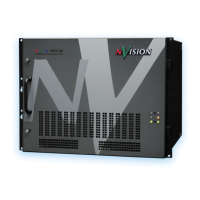NV5128 Multi-Format Router • User’s Guide 7
2. Introduction
Signals Types and Rates
Using Video and Audio References
References are required for proper switching. The following lists input signal formats and if a video
or AES reference is required
.
Mixing Analog and Digital
The NV5128 frame can mix analog and digital signals within a single routing system. For example,
a digital audio input can be routed to an analog audio output. To perform this action the router uses
analog-to-digital (A/D) converters and digital-to-analog (D/A) convertors.
There are two types of A/D and D/A converter cards: one set for audio and one set for video. Ana-
log audio converter cards cannot be mixed with analog video converter cards. The input signals
type
— audio or video — must match the output signal type. For more information on converter
cards, see Active Cards
on page 21.
The following is a list of audio and video inter-mix options and related delay times.
Input Signal Format Video Ref. AES Ref.
Analog Audio (Stereo) ** *
Analog Audio (Mono) ** *
Synchronous AES Digital Audio (Stereo) ** Yes
Synchronous AES Digital Audio (Mono) ** Yes
Mixed Analog and Synchronous AES Digital Audio ** Yes
Asynchronous AES Digital Audio (Stereo) ** No
Analog Video (PAL or NTSC) Yes No
SD Video Yes No
SWB Video Yes No
Time Code (Linear) Yes No
Machine Control (RS-422)** Yes No
* If possible, connect an external AES 48kHz reference signal.
** Video reference is not required for operation, but ensures proper video switching.
Input and Output Options Delay
Analog audio input and analog audio output < 1.2 mS
Analog audio input and AES synchronous output ~ 658 µS
AES synchronous input and analog audio output ~ 539 µS
AES synchronous input and AES synchronous output 83.2 µs (4 samples)
AES asynchronous input and AES asynchronous output < 1 µS
Analog video input and analog video output < 20 ns
Analog video input and SD output 1 video line
SD input and Analog video output 3 µS
SD input and SD output < 20 ns

